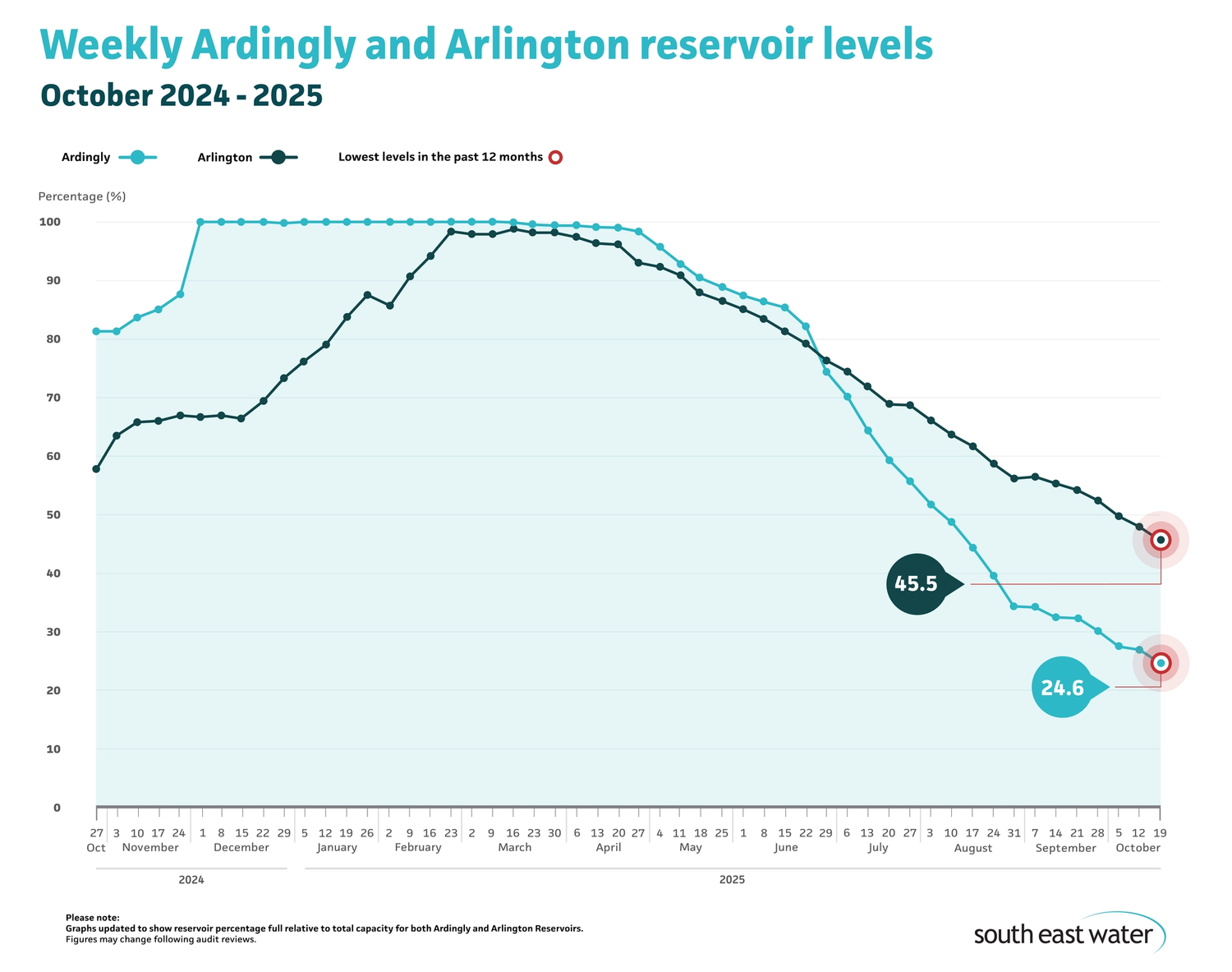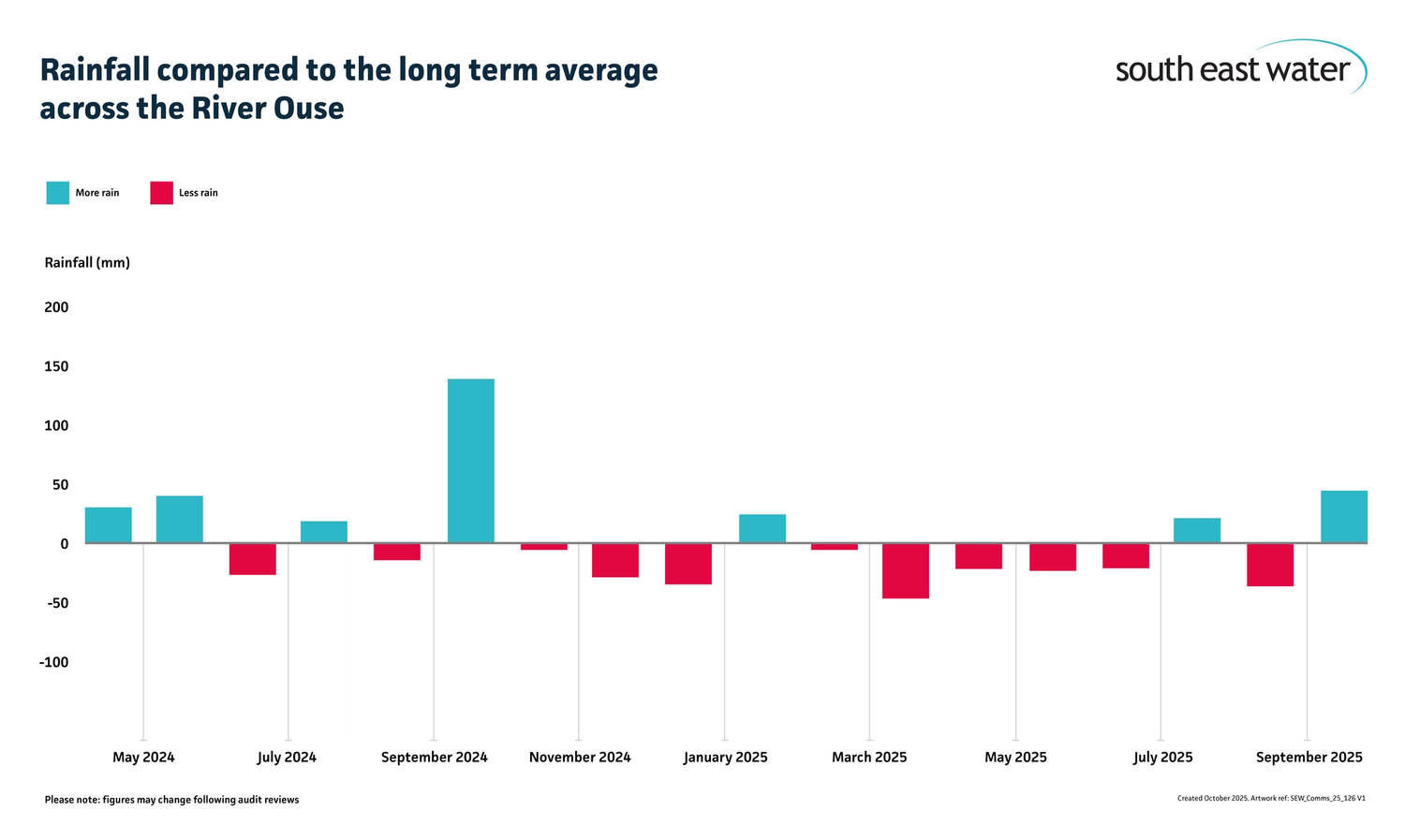The combination of factors experienced this year have been extraordinary - from record demand to prolonged periods of dry weather and a significant lack of rainfall.
This means it has been necessary to apply for a couple of different Drought Orders to protect customer supplies.
Drought Orders are decided on by the Secretary of State for the Environment, Food and Rural Affairs and allow us to make changes to abstraction licences or have the ability to restrict water uses.
Drought Orders do require there to be a consultation period, before a decision is granted.
Below you will find information on the two applications we have made:
- Drought Order for the River Ouse - Applied for on 10 October, consultation period now ended
- Drought Order for a Non Essential Use Ban (NEUB) - Applied for on 24 October, consultation period ends 31 October
Non Essential Use Ban Drought Order
On 24 October, we applied for a Non Essential Use Ban under a Drought Order. This is only an application, there are no guarantees it will be granted or needed. If granted, we would only implement it if the drought situation in Sussex becomes more severe. Although recent rainfall is helping, it hasn’t been enough to reverse the current conditions and we need to prepare should rainfall be lower than average for the rest of autumn and winter.
NEUB Drought Order Documents
Anyone may inspect the proposals free of charge at the addresses below during normal working hours (9am to 4pm), until 31 October at:
Ardingly Activity Centre,
Ardingly Reservoir, Ardingly,
West Sussex,
RH17 6SQ
South East Water,
Rocfort Road,
Snodland,
Kent,
ME6 5AH
What is a NEUB Drought Order?
A Non Essential Use Ban (NEUB) is a restriction on mains water use for commercial and non-household customers. We apply for this under a Drought Order and it requires approval by the Secretary of State.
Under a NEUB, the categories of mains water use which could be restricted are:
- Watering outdoor plants on commercial premises
- Filling or maintaining a non-domestic swimming pool or paddling pool
- Filling or maintaining a pond
- Operating a mechanical vehicle washer
- Cleaning any vehicle, boat, aircraft or railway rolling stock
- Cleaning non-domestic premises
- Cleaning a window of a non-domestic building
- Cleaning industrial plant
- Suppressing dust
- Operating cisterns in unoccupied buildings
This is an action included in our Water Resources Management Plan and Drought Plan, but we do not take it lightly. We only apply under exceptional circumstances, such as now.
How will this affect me?
At this stage we have only applied for a NEUB. We will continue to update businesses and non-household customers about the status of our application. You can find out more by visiting our FAQs here.
We understand your business needs a secure water supply to thrive. The restrictions, if granted and implemented, are only when using mains water, so you can still do the activities listed using recycled or harvested water where it’s safe to do so. We realise this is a significant change, but the water resource situation in Sussex needs us to all work together to keep the taps flowing for everyone.
Why have we done this?
This year has been exceptional. England has had the driest spring since 1893, the hottest summer on record, four heatwaves, but most importantly a significant lack of rainfall. This has had an impact on our water resources, and the rivers we take water from are running low.
We enforced a hosepipe ban for customers in Kent and Sussex on 18 July and placed more restrictions on customers in Sussex on 17 October, which has significantly reduced the demand for water, however it's still not enough. This meant all exemptions that were previously in place were removed, except for ones that are for health and safety purposes. We’re all doing everything we can, but as water resources continue to decline, we now need to look at non-household customer restrictions as a potential next step should the situation get worse.
Our reservoirs at Ardingly and Arlington, are much lower than we'd expect at this time of year. Ardingly Reservoir is now at a critically low level as a result of the lack of rainfall over the last 8 months, and record demand in the summer.

There is a significant risk that without more than 80 per cent average rainfall, resources will decline further without additional intervention, meaning customers' supplies may experience widespread issues such as low pressure or no water. We need to take this precautionary step to make sure that we have the ability to further safeguard resources should we need to.
Anyone who wishes to comment on our application can do so in writing to:
Water Resources Policy
Seacole Ground Floor
2 Marsham Street
London
SW1P 4DF
Or by emailing: water.resources@defra.gov.uk(opens in a new tab).
River Ouse Drought Order
On 10 October 2025, we applied for a Drought Order from the Secretary of State on the River Ouse.
We applied for this order because we have experienced extremely low rainfall this year, resulting in the water level at Ardingly Reservoir approaching critically low level.
River Ouse Drought Order documents
- River Ouse Drought Order Public Notice(opens in a new tab)
- River Ouse Drought Order Statement of Reason(opens in a new tab)
- River Ouse Drought Order Environmental Assessment Report(opens in a new tab)
- River Ouse Drought Order Environmental Assessment Report (Appendix A)(opens in a new tab)
- River Ouse Drought Order Draft Drought Order(opens in a new tab)
What this Drought Order would do
A Drought Order is similar to a Drought Permit in that it allows changes to be made to abstraction licences when there has been an exceptional shortage of rain. Both water companies and the Environment Agency (in England) can apply to the Secretary of State for a Drought Order to manage water resources for water supply and environmental benefit.
On a normal day, we must leave 20 million litres of water in the Lower Ouse below where we extract and treat water at Barcombe. If granted, the Drought Order would allow us to reduce the amount of water we leave in the River Ouse below Barcombe to 15 million litres a day, and if necessary, 10 million litres a day.
How it would help
While it’s a reduction, it will have a number of benefits:
- Preserving water resources for longer
- Enabling the water within the reservoir to replenish faster before next
summer - Ensure a baseline flow continues to be released into the upper
reaches of the river, benefitting the whole river system.
We have worked closely with Defra, the Environment Agency and Natural England on this Drought Order application, which retains the measures already in place within our Drought Permit, which was granted by the Environment Agency on 22 September 2025.
Will this affect me?
The Drought Order does not directly affect customers, however, to conserve as much water as possible we are making changes to the Temporary Use Ban (hosepipe ban) that is currently in place, which will affect customers in Sussex.
On Friday 10 October we announced that we are removing all exemptions from the ban for our customers in Sussex, except for the ones that are for health and safety purposes.
These exemptions include:
- Watering new lawns at domestic premises
- Watering trees, whips, saplings and hedges planted before the ban
and within the last three years - Watering food crops at domestic premises or private allotments
If you live in Sussex and we previously wrote to you to say you were exempt from the hosepipe restrictions, this will end and you will no longer be able to use your hosepipe.
If you were not exempt but activities you were doing were covered by an exemption, this will now also end.
There are some circumstances where a hosepipe is needed for health and safety purposes. Only these will be allowed.
We understand you may have some questions about this, and how this might affect you due to additional needs. You can read more about the updated restrictions below.
The decline of Ardingly Reservoir
You can see the decline of Ardingly Reservoir since March 2025 here, but since mid-June the reservoir has been dropping steadily and is currently at 24.6 per cent full.
Although we experienced high rainfall at the beginning of September, average rainfall between March 2025 and August 2025 in that area of Sussex has been around 63 per cent. That’s the ninth driest it’s been in the last 150 years.
Below is a graph to show the rainfall in the River Ouse area compared to the long term average from May 2024 to September 2025.

To fill Ardingly Reservoir at least 80 per cent of average rainfall is needed from now until February 2026. Forecasts currently suggest this level of rain will not be coming any time soon.
As you may know, Ardingly Reservoir provides a release of water, called the compensation release, into the Shell Brook (the stream which flows into the River Ouse) to compensate for the dam that was built to store water in the reservoir. Under our Drought Permit, which has already been granted, we have decreased the compensation release from four million litres a day, to one million litres a day, closer to the flow that would be there naturally at this time of the year.
As well as the compensation release, we also release enough water from Ardingly Reservoir for customer supplies, which we abstract at our water treatment works further down the river, to then treat for drinking water. After we abstract this water we must make sure there is 20 million litres left in the Lower Ouse part of the river, below where our treatment works are. If granted, the Drought Order would allow us to reduce the amount of water we leave to 15 million litres a day, and if necessary, 10 million litres a day.
